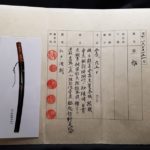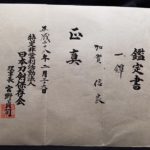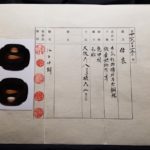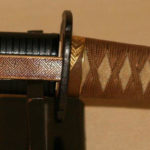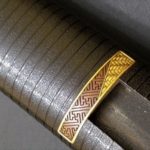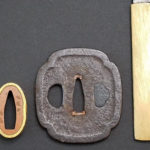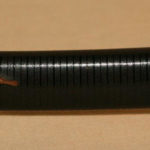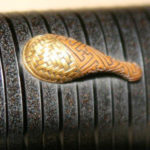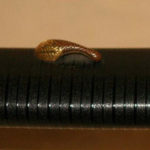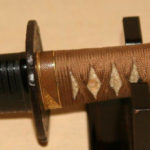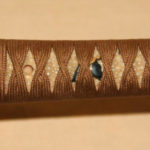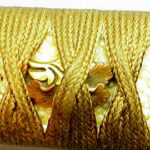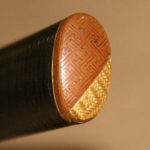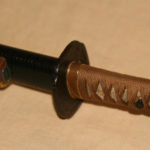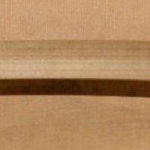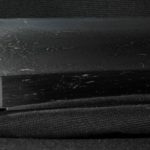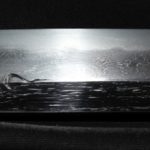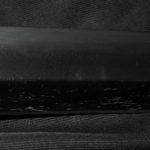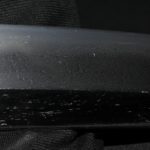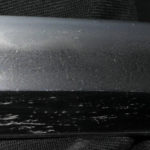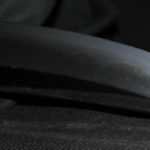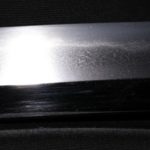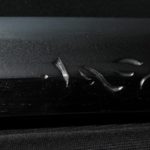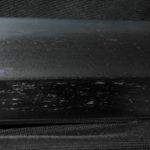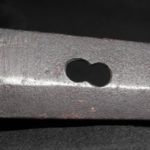Description
A Jumyo Wakizashi
shintô period Circa 1661 AD.
with fine matching fittings (Mid to late edo)
blade – NBTHK Hozon certificate
koshirae & tsuba – NTHK-NPO certificates
The Jumyo (寿命) school has its origins from Yamato (Nara prefecture) and moved to Mino province (Gifu prefecture) in the Kamakura period (1185-1333). The tradition continued for centuries, right up until the end of the Edo period in 1868. The main line separated in the 17th century into the Ishikiri and Kondo lineages. In addition, there were also the Owari-Jumyo. This line resulted from a migration of Mino smiths to Owari following Ieyasu Tokugawa’s defeat of the Imagawa clan. The Shodai of the Owari-Jumyo, Tango no kami Fujiwara Jumyo, was also the first in the Ishikiri lineage. The Owari-Jumyo lasted five generations (1579-1804).
The name Jumyo has been thought as very auspicious for longevity and used for gift and many swordsmiths used the same name for generations. It was believed that those who possessed a Jumyo blade were blessed with good fortune and longevity. Jumyo swords had a deserved reputation as wazamono blades with very good cutting ability. Interestingly, a superstition arose that a cut from a Jumyo sword would never heal. Presumably this was a comment on both the cutting ability of this school’s swords and their perceived auspicious nature.
This wakizashi has been attributed to “Shinto Jumyo” by the NBTHK, Hozon. Shinto Jumyo refers to a smith known as “Mino no Kami Jumyo” who worked around 1661 AD. His works were rated as Chu-jo saku. The koshirae received kantei-sho with score of 80 of 100, permitting the koshirae to be eligible for the yearly Yushu shinsa (considered to be the equivalent of NBTHK’s Juyo shinsa) held only in Japan. The tsuba received Kantei-sho with score of 74 of 100.
Swordsmith: Jumyô (寿命) (shintô, 新刀)
type: Wakizashi
Nagasa (cutting edge length): 38.5 cm Sori (curvature): 3 bu Motohaba (width): 2.7 cm
Boshi: komaru with turn-back
Hada: mokume-masame with sunagashi
Hamon: gunome notare w/ kinsuji, and inazuma
Horimono: Bonji (sanscrit characters)
Nakago: kiri-jiri (squared off), suriage, 2 mekugiana
Signature: Jumyô (寿命)
Note: blade has one small nick, about .5mm (pictured), no kizu (fatal flaws).
Certificate #1: NBTHK Hozon (a sword Worthy of Conservation by the Society for the Preservation of the Japan Art Sword),
Certificates #2 (koshirae), 3 (tsuba): NTHK-NPO Kanteisho (a sword’s koshirae and tsuba designated as Important by the Society for the Preservation of the Japanese Sword) koshirae scored – 80 of 100, tsuba scored – 74 of 100 (see shinsa worksheets linked further below) Note: Koshirae is eligible for the yearly Yushu shinsa held only in Japan.
Shirasaya: fine Japanese honoki wood with buffalo horn trim
koshirae: kodachi-koshirae with black ishime kizami-saya, tsuka: white same, golden brown hishimaki wrapping, fuchi- kashira: signed “Kiryûken Yoshimori” (起龍軒美盛), gold and shakudô sogetsugi, wickerwork and sayagata decoration, menuki: shakudô and suaka in katachibori, iroe, motif ginko, kozuka: en in suite, suaka, back side gilded, sayagata decoration, Other: uragawara, kurigata, kojiri en suite with other fittings, KANTEI: late Edo period, 80/100 points
tsuba: mei “Nobuie” (信家), mokkô-gata, two hitsu-ana (one plugged with shakudô), iron, migaki-ji, sukinokoshi-mimi, kikkô pattern as main decoration, kebori KANTEI: Kaga, mid-Edo period 74/100 points
Included: carry bags
-Price $12,000 USD in new Polish. I have new photos by request for the moment until I take new with my Nikon. 11/2023
NBTHK Hozon certificate
kantei-sho (鑑定書) No 3001693
wakizashi, mei: Jumyô (寿命) (shintô, 新刀)
nagasa 1 shaku 2 sun 7 bu kyô
Migi wa tô-kyôkai ni oite shinsa no kekka, hozon-tôken to kantei-shi kore o shô-suru.
(右は當協會に於て審査の結果保存刀剣と鑑定しこれを証する)
Heisei nijûgonen ichigatsu nijûkunichi (平成二十五年一月二十九日)
kôeki-zaidan-hôjin (公益財團法人): Nihon Bijutsu Tôken Hozon Kyôkai (日本美術刀劍保存協會)
Appraisal
wakizashi, signed: Jumyô (Shintô)
nagasa ~ 38.5 cm
According to the result of the shinsa committee of our society we judged this work as authentic and designate it as hozon-tôken.
January 29th 2013
[Foundation] NBTHK
kantei-sho (鑑定書) – Certificate
katana-koshirae (刀拵)
chiisagatana-koshirae with ribbed lacquer saya and en suite dark ishime-ji fittings
(皆具黒石目地塗刻鞘小さ刀拵え)
shôshin (正真) – Authentic
Heisei 28 nen 2 gatsu 26 nichi (平成二十八年二月二十六日) – February 26th 2016
Non Profit Organization (特定非営利活動法人)
Nihon Tôken Hozon Kai (日本刀剣保存会) – NTHK
Board Chairman (理事長): Miyano Teiji (宮野貞司)
No T. 1600151
meibun (銘文) – Signature: mumei
tsukurikomi (造り込み) – Shape:
shitaji (下地) – Foundation:
zugara (図柄) – Motif/Design:
hori (彫り) – Carvings/Engravings:
sunpô (寸法) – Measurements: overall length 65.0 cm
koshirae (拵え) – Mounting: tsuka with white same and golden brown hishimaki wrapping;
fuchigashira of gold and suaka in sogetsugi interpretation and
showing a net and sayagata design; menuki of shakudô and
suaka, in katachibori and iroe, depicting ginkgo;
kurigata, uragawara, kojiri and kozuka en suite with the kozuka
signed “Kiryûken Yoshimori” (起龍軒美盛)
bikô (備考) – Remarks: late Edo period
shinsa’in natsu’in (審査員捺印) – Seals of Judges: 5 seals
kantei-sho (鑑定書) – Certificate
tsuba (鐔)
Kaga, Nobuie (加賀、信家)
shôshin (正真) – Authentic
Heisei 28 nen 2 gatsu 26 nichi (平成二十八年二月二十六日) – February 26th 2016
Non Profit Organization (特定非営利活動法人)
Nihon Tôken Hozon Kai (日本刀剣保存会) – NTHK
Board Chairman (理事長): Miyano Teiji (宮野貞司)
No T. 1600150
meibun (銘文) – Signature: Nobuie (信家)
tsukurikomi (造り込み) – Shape: mokkô-gata, two hitsu-ana (one plugged with shakudô)
shitaji (下地) – Foundation: iron, polished finish, sukinokoshi-mimi
zugara (図柄) – Motif/Design: kikkô pattern
hori (彫り) – Carvings/Engravings: kebori
sunpô (寸法) – Measurements: height 6.8 cm, width 6.2 cm
koshirae (拵え) – Mounting:
bikô (備考) – Remarks: mid-Edo period
shinsa’in natsu’in (審査員捺印) – Seals of Judges: 5 seals
Gallery
This Sword is available for purchase.
If you wish to purchase contact us directly via email or contact us at 1(608) 315-0083 any time.
Pictures and content may not be copied without the express permission of samuraisword.com ©







